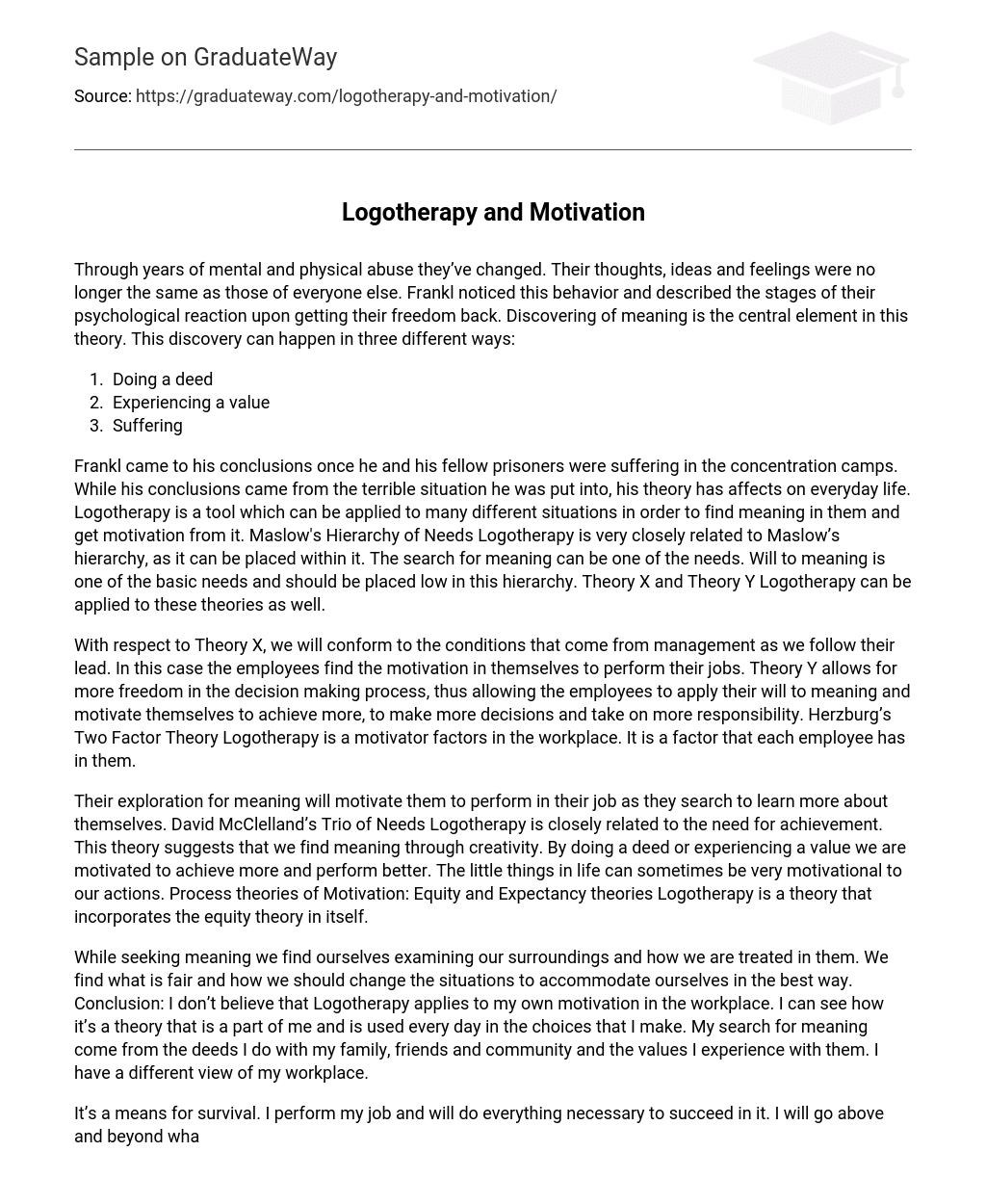Through years of mental and physical abuse they’ve changed. Their thoughts, ideas and feelings were no longer the same as those of everyone else. Frankl noticed this behavior and described the stages of their psychological reaction upon getting their freedom back. Discovering of meaning is the central element in this theory. This discovery can happen in three different ways:
- Doing a deed
- Experiencing a value
- Suffering
Frankl came to his conclusions once he and his fellow prisoners were suffering in the concentration camps. While his conclusions came from the terrible situation he was put into, his theory has affects on everyday life. Logotherapy is a tool which can be applied to many different situations in order to find meaning in them and get motivation from it. Maslow’s Hierarchy of Needs Logotherapy is very closely related to Maslow’s hierarchy, as it can be placed within it. The search for meaning can be one of the needs. Will to meaning is one of the basic needs and should be placed low in this hierarchy. Theory X and Theory Y Logotherapy can be applied to these theories as well.
With respect to Theory X, we will conform to the conditions that come from management as we follow their lead. In this case the employees find the motivation in themselves to perform their jobs. Theory Y allows for more freedom in the decision making process, thus allowing the employees to apply their will to meaning and motivate themselves to achieve more, to make more decisions and take on more responsibility. Herzburg’s Two Factor Theory Logotherapy is a motivator factors in the workplace. It is a factor that each employee has in them.
Their exploration for meaning will motivate them to perform in their job as they search to learn more about themselves. David McClelland’s Trio of Needs Logotherapy is closely related to the need for achievement. This theory suggests that we find meaning through creativity. By doing a deed or experiencing a value we are motivated to achieve more and perform better. The little things in life can sometimes be very motivational to our actions. Process theories of Motivation: Equity and Expectancy theories Logotherapy is a theory that incorporates the equity theory in itself.
While seeking meaning we find ourselves examining our surroundings and how we are treated in them. We find what is fair and how we should change the situations to accommodate ourselves in the best way. Conclusion: I don’t believe that Logotherapy applies to my own motivation in the workplace. I can see how it’s a theory that is a part of me and is used every day in the choices that I make. My search for meaning come from the deeds I do with my family, friends and community and the values I experience with them. I have a different view of my workplace.
It’s a means for survival. I perform my job and will do everything necessary to succeed in it. I will go above and beyond what is asked of me to achieve all that I can, but at the end of the day it doesn’t define me. My work is not the meaning of my life. My search for meaning does motivate me in some ways in the workplace, but I view it as one of the lower needs as applied to Maslow’s hierarchy. It’s also a need that I satisfy myself, while higher needs are satisfied by my manager and the organization. It is not very relevant to my own motivation in the workplace.
Logotherapy is a relevant tool when trying to motivate others. It is very helpful in establishing relationships while motivating others. It also allows managers to show alternate ways to view situations. This can motivate their subordinates to seek unorthodox solutions that may have not been considered previously. While Logotherapy is a relevant tool, it is not the only theory that should be used by managers to motivate. It has a narrow concentration and will not lead to successful results in motivating employees to achieve their very best, but it will certainly help along the way.





